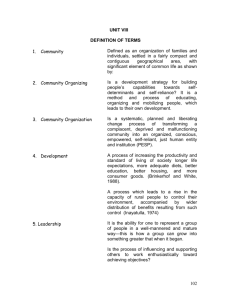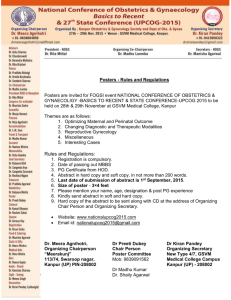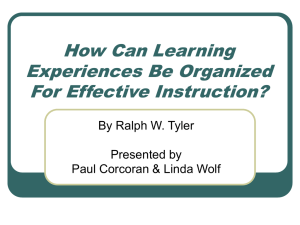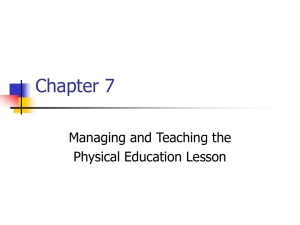Unit II: Community Organization: Values, Goals and Principle
advertisement
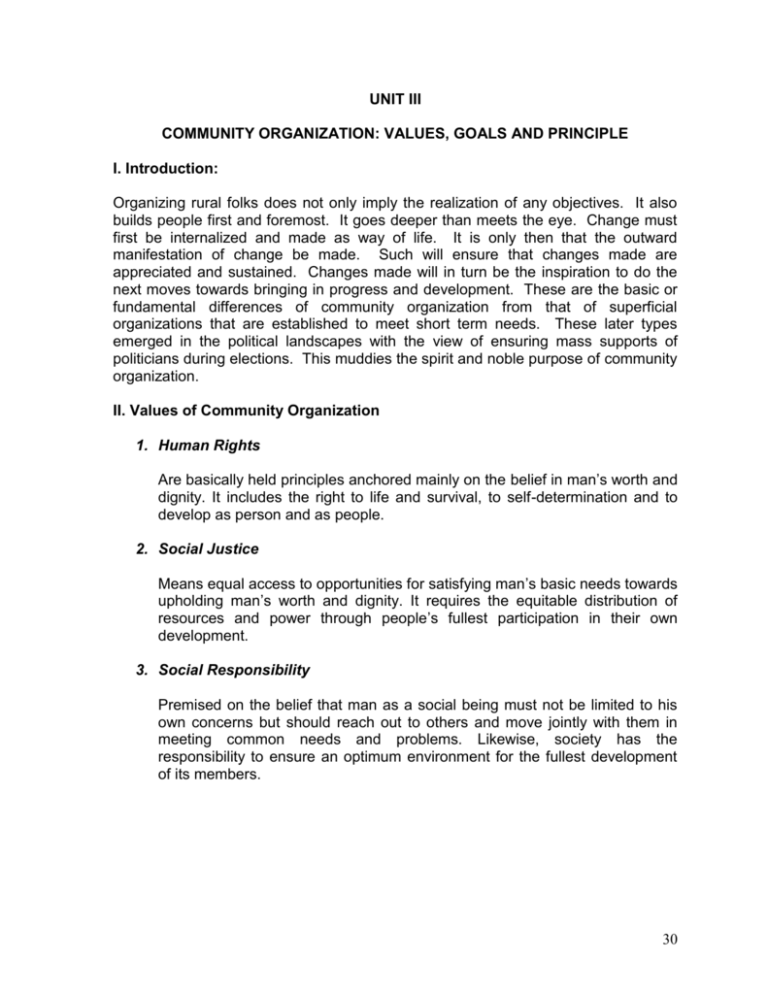
UNIT III COMMUNITY ORGANIZATION: VALUES, GOALS AND PRINCIPLE I. Introduction: Organizing rural folks does not only imply the realization of any objectives. It also builds people first and foremost. It goes deeper than meets the eye. Change must first be internalized and made as way of life. It is only then that the outward manifestation of change be made. Such will ensure that changes made are appreciated and sustained. Changes made will in turn be the inspiration to do the next moves towards bringing in progress and development. These are the basic or fundamental differences of community organization from that of superficial organizations that are established to meet short term needs. These later types emerged in the political landscapes with the view of ensuring mass supports of politicians during elections. This muddies the spirit and noble purpose of community organization. II. Values of Community Organization 1. Human Rights Are basically held principles anchored mainly on the belief in man’s worth and dignity. It includes the right to life and survival, to self-determination and to develop as person and as people. 2. Social Justice Means equal access to opportunities for satisfying man’s basic needs towards upholding man’s worth and dignity. It requires the equitable distribution of resources and power through people’s fullest participation in their own development. 3. Social Responsibility Premised on the belief that man as a social being must not be limited to his own concerns but should reach out to others and move jointly with them in meeting common needs and problems. Likewise, society has the responsibility to ensure an optimum environment for the fullest development of its members. 30 III. Goals of Community Organizing 1. People’s Empowerment Empowerment means the long-term strategic process of transferring economic and social power from one center to another and or the creation of new centers of socio economic power in competition with traditional centers. People’s power is the collective consciousness and action on social issues pushing for social transformation and premised on truth, justice, freedom, and liberation. It is organized by the people and is used by them to advance their collective interest. It requires people’s participation and a dialogical relationship among themselves. Through the process of community organizing, people learn to overcome their powerlessness and develop their capacity to maximize their control over their situation. It is the progressive realization of the power that they process and the ability to influence the course of history that dramatically erodes the dehumanizing effects of powerlessness. In the process of confronting the structure and institutions that oppress them, people are transformed from dehumanized objects into human beings who assert their rights, determine their destiny and start with dignity as a whole human being. 2. Building Relatively Permanent Structures and People’s Organization. Community organization aims to establish and sustain relatively permanent organizational structures that best serve the needs and aspirations of the people. These structures ensure maximum people’s participation while at the same time provide the venue through which the people’s organization can link up with other groups and sectors. It is trough these structures that people can begin to test alternative ways of doing things and internalize a new system of values so that localized experiences become the building blocks upon which the blueprint of a more desirable future is based. 3. Building Alliances People’s organization and community organizers should build and/or join any or all alliances that are useful to the people. This refers to sectoral alliances, other people’s organization and alliances, multi-sectoral coalition, regional and national alliances, political parties and international organization. However, one should always be conscious of the differences between: Tactical Alliances – short term level of issues and therefore forged at times with the enemies, and 31 Strategic Alliances – long term, on the level of issues as on the more comprehensive bases of unity, with friends and like minded groups, especially those with whom a unified political line is possible. Such alliances must not detract from the autonomy and independence of the people’s organizations and must be based on a genuine respect for the integrity of each group and must ensure genuine people’s participation. 4. Improved Quality of Life/Standard of Living Community Organizing also seeks to secure short and long term improvements on the quality of life of the people. Immediately, the process of mobilizations can gain concessions for fulfilling the basic needs for food, clothing, shelter, education and health. In the long term, community organization should create a conducive environment for the development of human creativity and solidarity through the equitable of power and resources. 5. Popular Democracy Corollary to the other goals, popular democracy means popular empowerment of the development of people’s organization that shall serve to facilitate sustained people’s participation in decision making and governance. At the level of formal government processes, it calls for effective devolution of power to the grassroots, decentralizing policy-making structures and bringing points of decision making closer to the grassroots and more accessible to popular involvement. It will mean some form of socialization of state power with sectoral representation on all level of policy making. It is characterized by the pluralism in political vision. Democratization of wealth or access to social resources is a precondition to popular democracy. 6. National Social Transformation Community Organizing seeks not only the solution to the existing problems but ultimately works towards a transformed society with the following features: Democratic because it is premised on the foundation of a strong, popular autonomous people’s organization. This is in complete contrast to an over centralized system where the state exercises too much control and where an oppressive bureaucracy necessarily develops. Nationalistic because its focus is on the Philippines. A community organizer must be consciously pro-Filipino and, therefore, anti imperialist. Self-Reliant and Self-Governing because we must retrieve our sovereignty if we are to start our own destiny. 32 Equitable distribution of wealth according to his or her own effort, contribution and need. Collective ownership of the vital means of production, which refers to the collectivization of those that are used for the exploitation of other human beings and/or those, the private ownership of which deprives others of the means of survival. Pluralistic and mass-based because it allows for the freedom of different political forces to pursue their own political line on the presumption that in the final analysis a political line can be validated only by the people. IV. Principles of Community Organizing 1. People’s Participation It is the sharing of duties, power, benefits / privileges. It is the involvement of the poor and powerless in their development, especially in all phases of decision-making. Community organizing recognizes and respects the primary role of the people in the task of social transformation. Community organizing must therefore be participatory and mass-based. 2. Self-Determination The need for challenge must come from within, from people’s awareness of their own problems and their will to act on them. People are the makers of history and have the power to shape their destiny if only they are made aware of their options, the consequences of each option and should be responsible for their choice/decision. This implies a respect for their ability to confront, understand and deal with the roots of their problems, and to build their own vision in an alternative society. 3. Experiential Learning Community organizing involves learning through practice, e.g. the continuing refinement of theory and understanding through practice. Action reflects people’s experiences on collective decision-making. Mobilization facilitates the learning and development of knowledge, attitudes and skills in problem solving. 33 4. Self Reliance The process that releases the creative energy of people through the maximum and optimum use of local human and material resources/capabilities. It includes all aspects of the following objectives. Priority on producing for and meeting the basic needs of all members of society and by society Maximum initiation of development by local people, and full participation of the people in all phases and aspects of the development process. Priority focus on the development and optimal utilization of local resources, structures and processes. Stimulation and nurturance of indigenous initiative, creativity, knowledge, skills and culture. Reduction in the scope and opportunity for relationships based on dominance or dependence between sectors and groups involved in development. Maximum sharing of both benefits and costs of development at all stages and across all sectors and levels of society. Promotion and support of indigenous social institutions, especially those strengthening the family and cohesive communities that link and collaborates together on an equitable basis. V. Organizational/Tactical Principles Unlike the basic principles outlined above, tactical principles are more specific and serve as guidelines for tactical operations in organizing. 1. Start where the people are. Organizers may have to begin with the felt needs which maybe concrete, simple, short term and personal issued by many people in the community. 2. Recognize Self-interest. Interest as an initial motivating factor for people’s involvement, but to be effective, it must aim at multiplicity of goals to ensure a bread base of support. Self-interest must later be transformed into acts which liberate not only some people but also the whole oppressed class. 34 3. Use conflict or controversy in agitating change. Organizers should identify widely and urgently felt community problems and for discontent to stimulates people to action. 4. Initial activities/projects must be specific. With immediate end and feasible results to create self-respect and confidence among the people through success. 5. Move from simple, short term issues to more complex, abstract, systematic and structural issues gradually buildings on the people’s experiences and growing capabilities. Tackles all problems especially the root problems. This means to consider the personal, social, structural problems on the micro level as related to the macro. The people must develop progressive, strategic and tactical plans and actions. 6. Create historical models as symbols of possibility of what can be done and what people are capable of. This encourages people to have both patience and sense of urgency. 7. In establishing people’s organization, its structure should have: Maximum people’s participation Maximum control by the people. There should be structural measures to avoid the leader-oriented and too centralized decision making process. Simplicity. Avoid bureaucratic structures by setting up the necessary and functional committees only. 35
